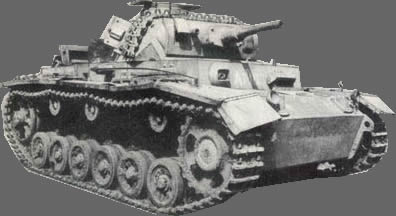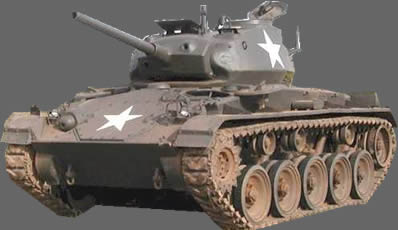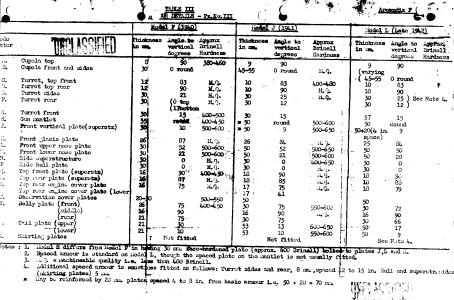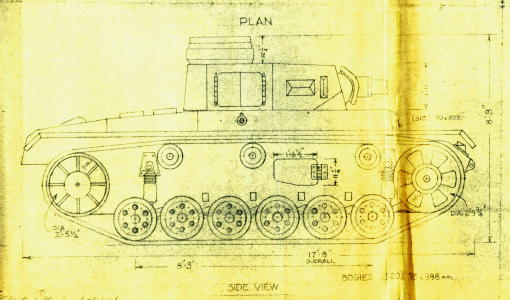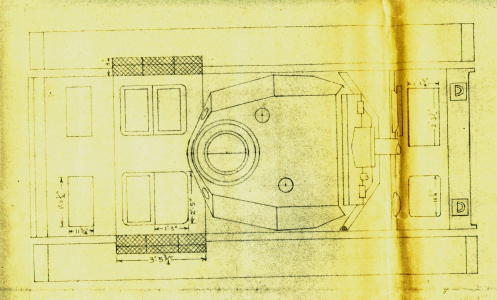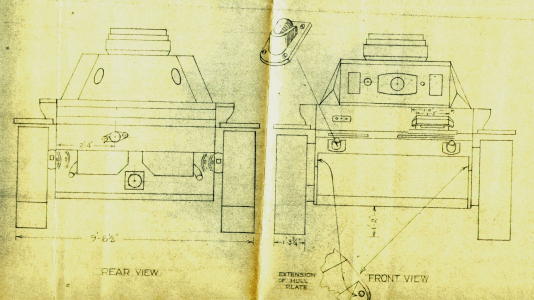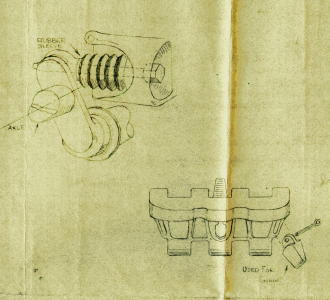|
Get
to know your VMMV staff & vehicles
In
this section we introduce you to the people and armor of the
Virginia Museum of Military Vehicles. We will chat with the
VMMV staff, so that you can get to know the people who "keep
'em running" and work so hard behind the scenes. And also
provide a behind-the-scenes look into the history of individual
vehicles in the VMMV collection. In this, our fourteenth newsletter,
we interview one of VMMV's most fascinating volunteers and a
veteran....LTC. Neal N., United States Army.
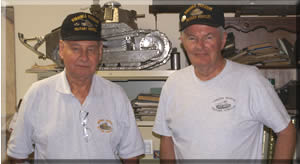 |
|
Neal
and Allan at the tank farm.
|
Neal
is an example of the amazing kind of volunteers at VMMV…experienced
in many types of military operations, incredibly varied background
and a couple of very unique anecdotes (Hint: they are measured
in megatons!)
LTC.
N. was drafted into the Army in 1945 at age 17 and had to have
his father sign his induction papers. Initially assigned to
the artillery, Neal changed to the infantry and was sent to
the 6th Infantry Division in the Philippines and then on to
Korea as part of the Occupation Force.
Neal
stayed in Korea for about two years and got out in 1948, passing
into the inactive reserve. Like so many of the "Greatest
Generation," Neal went to college after WWII and got married.
But events back in his old AOR interrupted his plans. When the
Korean War broke out in 1950, Neal was the first inactive reserve
officer from the state of New Jersey to be recalled to active
duty. Sometimes being first isn't the best! He was assigned
to Fort Dix and was in charge of Basic Training for all the
new inductees headed off to Korea. Most of the trainees went
straight to war along with their instructors. But the Army personnel
system had other plans for Neal.
Instead
of the frozen mountains of Korea, Neal was assigned to Austria
by sheer luck, no string pulling at all! He was assigned to
the HQ of an intelligence unit and after a long talk with his
wife, decided to go Regular Army and was sent to the 350th Infantry
as a rifle company commander. His paperwork for his regular
army appointment, however, came thru as Corps of Engineers,
so Neal
made a transition to his fourth military specialty and served
in the 352nd Engineer Company (separate.) Because this was a
"separate" unit, Neal reported directly to a Brigadier
General, without having to go thru normal regimental channels....probably
his "best tour."
Coming
back to the States, Neal became an instructor at the Engineer
School (located at nearby Fort Belvoir at the time.) While at
the school, he specialized in Atomic Weapons Instruction and
observed two of the TEAPOT DOME nuclear tests in the Nevada
desert (more later.) Demonstrating the Army's commitment to
education, Neal was sent to Lehigh University for graduate school
and then back to US Forces Korea to serve on the Engineer Staff.
In
Korea, Neal was in charge of monitoring the US nuclear weapons
deployed on the peninsula. Not the bombs delivered by fighter
aircraft, but munitions (BIG ONES) used by the US Army to destroy
bridges and demolish infrastructure (commonly referred to as
Atomic Demolition Munitions (ADM)) in order to slow a North
Korean invasion. In the 1950's, Neal states that nuclear weapons
were still pretty crude and that it was difficult to assemble
the detonators….they had to be polished and inserted in
precisely the correct order or the munitions would not go high
order.
After
that, another tour in the United States as Base Commandant for
Fort Mason in San Francisco CA, right next to the Presidio.
Fort Mason was the main staging point for US dependents transiting
to the Pacific Theater, so Neal had a wide variety of jobs and
duties, including servicing the federal prison at Alcatraz.
And yes, Neal was locked up at Alcatraz once by the warden….but
just for demonstration purposes!!! Then back to school again,
this time to Fort Leavenworth. By this time, Neal was a Major.
From
Fort Leavenworth, Neal resumed his atomic duties, but now in
Germany as part of US Forces, Germany, Engineer Section. Neal
briefed on the subject of US atomic weapons to NATO HQs and
the French.
Like
so many other US Army personnel, Neal was then sent to Vietnam
in 1967-68, serving during the Tet offensive. Also, Neal was
the focal point for coordinating logistics and resupply operations
for the Marines during the battle of Khe Sanh. Neal supplied
the USMC with beans and bullets and all the other vital supplies
they needed. He worked in a supply chain stretching from Germany
to Cam Ranh Bay. For his superb work during this battle, Neal
was awarded the Legion of Merit personally by Gen. Creighton
Abrams, - head of Military Assistance Command-Vietnam (MACV.)
After
a tour back at the Pentagon, Neal was sent back to Vietnam in
1969 where he began planning for the retrograde movement of
US army troops and supplies in case a truce was ever declared.
Neal, now an O-5 light colonel, decided to get out of the US
Army after 25 years in the latter part of 1969.
Now,
on to a couple of specific questions.
LTC.
N., as an engineer officer in Germany during the height of the
Cold War, did you have any "special" assignments that
you can now talk about?
Yes,
one time several government types asked my engineering unit
to help bury a couple of truckloads of weapons and explosives
in the german countryside. We placed M1 and M2 carbines, M1
Garands, hand grenades, C-4 and other munitions in a hole, covered
it up and then spread normal "garbage" across the
top as a disguise. We later were told these caches were for
an internal resistance movement organized by US special forces
designed to operate behind enemy lines in case of a Soviet invasion.
What
was the biggest blast you ever detonated or witnessed as an
engineer officer?
Unfortunately,
it was not by design. We were in Germany and had twenty five
of the battalion trucks each towing a five ton trailer loaded
with explosives ready to go. In case of invasion, our job was
to take these explosives and drop bridges and blow holes in
roads to slow up the Soviets. One of our soldiers was suffering
from some mental health issues and got into the alert compound
and blew up two trucks. Fortunately, I had a great relationship
with the local burgermeister and we both worked to mitigate
the consequences. I had my soldiers sweep the nearby town for
any unexploded ordnance and repaired any damage. When the 3-star
Corps Commander showed up in my office, I knew things were at
a critical point, but luckily our strict adherence to on-base
safety procedures vindicated all the wonderful men and women
under my command.
Tell
us about the incredible experience of participating in two nuclear
blasts as a test subject.
As
I said before, I was deeply involved in the operational use
of atomic munitions for engineering demolition and was sent
to Nevada for two of the TEAPOT DOME blasts. We were in a slit
trench about 4000 meters from ground zero with very dark goggles
on. After detonation, the pressure wave washed over us and we
could feel the heat from the fireball and mushroom cloud. As
dark as the blacked-out goggles were, we could still see the
mushroom cloud perfectly because of its intensity. Then, we
walked towards the recently formed crater, getting closer and
closer until our dosimeters pegged!
What
is your favorite military vehicle of all time?
Jeep!!!
A fantastic, multipurpose vehicle that served the Army well
for decades. My favorite tank is the M-24 Chaffee-good suspension,
two V-8 engines and a useful gun for a light tank.
What
is your favorite tank in the VMMV collection?
T-34.
I believe it is the epitome of a WWII tank. At Kursk it was
outstanding and fought the German Tigers and Panthers to a standstill.
It was also innovative, using a pressurized air bottle to blow
start the engine during the cold Soviet winters that would drain
a battery in an instant.
Ketchup
or Mustard?
MUSTARD!!!
|

